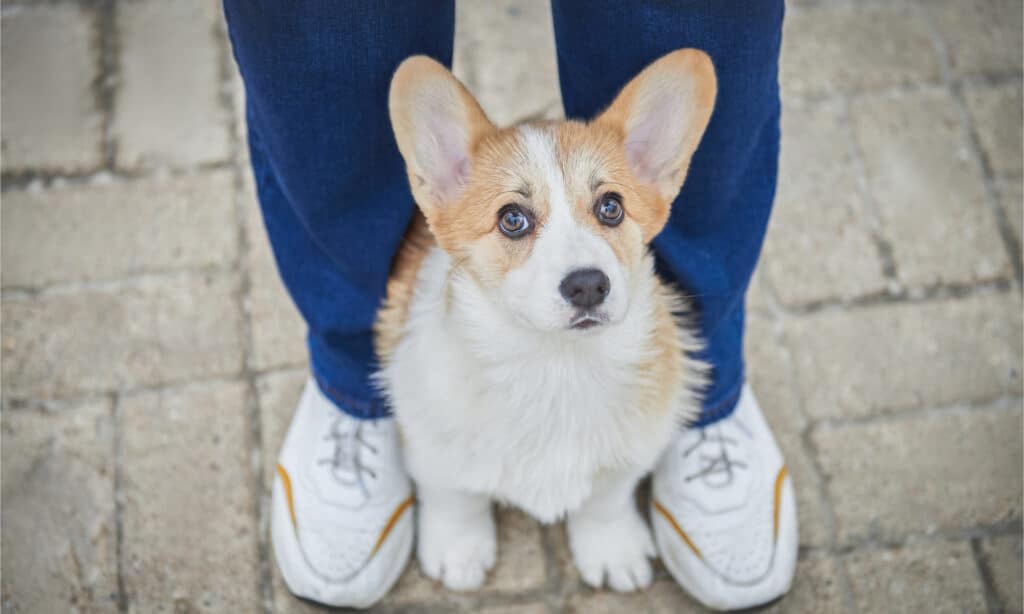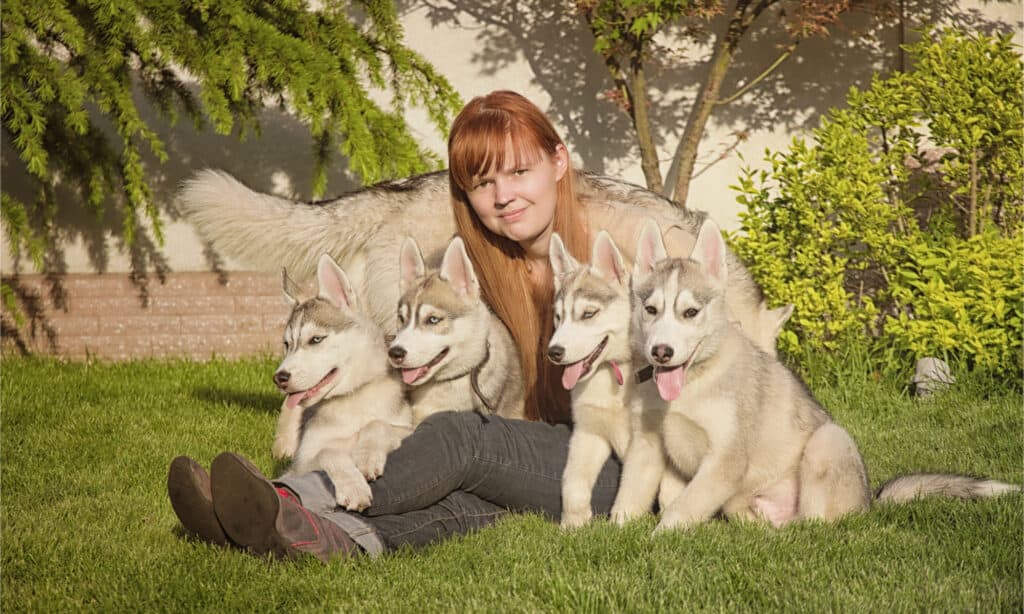It is a common misconception that when a dog lays or sits on your feet it is trying to assert dominance over you. This theory couldn’t be further from the truth. Dogs generally form strong bonds with their owners and wherever the owner goes, the dog will follow. When you take a seat and your dog plops down right on your feet, it is an indication of a strong relationship between you and the dog in his eyes. There are many other reasons why dogs exhibit this behavior as well, read on to learn more.
Why Does My Dog Sit On My Feet?
There are many different reasons why your dog may like to sit on your feet. We’ll take a look at some of the most common reasons below:
Your Dog Is Showing Its Love
It is actually normal behavior for your dog to show its love by sitting down on your feet. In a way, it’s similar to if a person were to sit down next to a friend or loved one. Some dogs are okay with staying on the floor rather than jumping up on the couch or in your chair with you, so they’ll take their seat right on top of your feet. It might also do this if you have carpeted floors and it prefers the texture of the carpet to that of the couch.
Sometimes laying close to their owner on the couch can make them too warm so they’ll choose to stay seated on the floor—especially if you have hardwood floors or a surface that stays cooler in the warmer months.
Another reason why your dog may choose to lay on your feet is so that they can be ready to stand up and follow you the moment you get up from your seat. This is especially true if you have an older dog that has a hard time jumping onto and off of higher surfaces.

One of the many reasons your dog sits on your feet is to show its love
©e-Kis/Shutterstock.com
Your Dog May Have Anxiety
In some cases, a dog may choose to sit or lay down at its owner’s feet because they’re feeling fearful or anxious. If your dog begins exhibiting this behavior suddenly, you may want to pay close attention to its behavior from that point on. Here are a couple of things you’ll want to look out for:
- Are they showing signs of being in a state of fear and stress? (Excessive panting and/or drooling)
- Is the dog’s tail hanging low to the ground or tucked between its legs/underneath them?
- Are their ears pulled back and their head lowered?
If your dog is displaying any of the above traits, he may be suffering from anxiety. This could also explain why he is sitting or laying on top of your feet when he normally wouldn’t display this behavior. Anxiety can occur in dogs for a variety of reasons—including underlying health conditions. If your dog begins showing signs of anxiety, be sure to make an appointment to see the vet so that they can be checked for any undiagnosed health issues.
You might also notice your dog behaving this way if they’re in an unfamiliar place or around other animals that they aren’t used to, such as a new family pet. They can also display anxious behavior when they hear certain noises such as thunder, fireworks, or loud construction work.
When your dog is afraid, simply being close to you can help them feel more at ease. If your vet has ruled out any underlying health issues for your dog, you might want to consider using CBD for dogs to help lessen your dog’s anxious feelings. CBD can help ease worry, fear, anxiety, and stress if you find that this is the sole reason for your dog staying close to you and exhibiting anxious symptoms.
Learned Behavior
Dogs learn that when they do certain things, they get certain responses —that means if they get positive attention from you when they sit at your feet, they are more likely to do it again. Your dog may have learned from you that when he sits on your feet, you talk to him or give him rubs behind the ears. Or if he lays on his back at your feet, you give him belly rubs. The dog will then begin to associate sitting or laying on your feet with a positive outcome. This positive reinforcement is what makes your dog continue the behavior.
Pack Mentality
Dogs are very social creatures and they have a pack mentality ingrained into their DNA. Even if your dog has never spent a moment in the wild, he will still have the innate tendency to sit on your feet as remnants of his ancestral behaviors. No, wild dogs didn’t sit on each others’ feet, but they did huddle closely together. They did this in order to keep safe while traveling in packs and working closely together to survive out in the wild.
When the wild dogs rested, they’d huddle together allowing the leader of the pack to have the ideal vantage point while everyone else lay nearby. This also falls in line with a dog’s natural guarding instincts, which allows a dog to protect his pack. Laying on or at your feet can be a dog’s way of putting himself between you and any potential danger.

Sitting closely with its pack members is ingrained in dogs’ DNA
©Voltgroup/Shutterstock.com
Claiming Its Territory
Your dog may look at you as his prize, so he may be laying on your feet as a way of claiming you for himself as his territory. If your dog tends to display this behavior while you’re out in public places like parks, he is probably marking his territory and showing the other dogs in the area that you belong to him.
This type of behavior might be a problem for some owners that have a multiple dog household. You might find that your dogs tend to fight over who gets to lay down on top of your feet. If this is the case, you might want to seek help from a dog behaviorist. This will lessen the chances of any of your dogs getting hurt from one or more showing aggression. Retraining their behavior, however, will take time so be patient with them as they learn.
Managing power struggles such as these should be done only with positive reinforcement. The best way to solve it might be to ensure that each dog has a spot next to your feet if there is room, that way neither dog can claim both of your feet for itself. Working with a professional will help reduce or eliminate the behavior. Also, be sure that each dog gets plenty of its own individual time with you.
Comforting You
Dogs are actually really good at picking up on our emotional cues. If your dog senses that you are sad, sick, or showing signs of stress, he will come near you to help you feel better. Your dog knows that its presence makes you happy and so it will try to lay as close as possible to you if it feels like you’re not feeling well or if you’re sad or stressed.
On the other hand, as we mentioned before, your dog may be laying at your feet as a way of comforting itself. Changes to your dog’s routine or environment can cause stress and anxiety in your dog. Strangers in the house, loud noises, rearranging furniture, can all create anxiety—therefore your dog may lay or sit on your feet so that it feels more comfortable.
Should I Allow My Dog To Sit On My Feet?
Whether your dog is sitting on your feet because he is cold, wants to claim you as his territory, or is feeling unsafe, allowing him to do this shows him that you love and support him. Allowing this behavior is a way to show your dog that you care about him and give him reassurance that you are there to keep him safe.
Dogs look to their humans to meet their basic needs like providing food and a safe place to call home. Being able to lie at your feet during times of stress or loneliness confirms to him that he is an important part of your life and that you care about his safety and comfort.
If for whatever reason you are not comfortable with your dog laying at or on your feet, there are ways that you can train it to lie next to you instead of right at or on your feet. The first thing you’ll want to do is make sure that you’re not further encouraging the behavior. This means that when your dog lays at your feet, make sure that you’re not giving him positive reinforcement like petting or rubbing if you do not want him to continue the behavior.
Some training techniques that you can try include tossing treats to your dog away from where you are sitting and teaching the dog to stay at a distance. Whatever method you choose to train your dog, always practice it with kindness and positivity. You never want to yell or create fear and stress for your dog in the process.
How do I know if my dog thinks he is Alpha?
While we are looking at and analyzing dogs’ behavior, let us examine some characteristics and signs that may point to whether or not your pup considers himself to be the alpha in the house.
One common indicator for this scenario is if your dog tends to growl at people (and including at you) if they get close to their food bowl. Alpha dogs will show signs of being possessive of their items and food and even take your things. This is just one example of them asserting dominance, which favors the pack leader in the wild and helps provide stable leadership and general hierarchy within a pack.
Another less obvious clue that your hound may see itself as the alpha, is if it stares at you and does not break eye contact. Dogs that are submissive will often look away and perhaps hold their heads down rather than posturing a more challenging stance.
The photo featured at the top of this post is © OlgaOvcharenko/Shutterstock.com
Ready to discover the top 10 cutest dog breeds in the entire world?
How about the fastest dogs, the largest dogs and those that are -- quite frankly -- just the kindest dogs on the planet? Each day, AZ Animals sends out lists just like this to our thousands of email subscribers. And the best part? It's FREE. Join today by entering your email below.
Thank you for reading! Have some feedback for us? Contact the AZ Animals editorial team.






